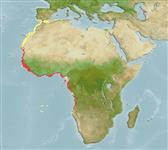Preferred temperature (Réf.
123201): 18.5 - 28, mean 25.2 °C (based on 140 cells).
Phylogenetic diversity index (Réf.
82804): PD
50 = 0.5156 [Uniqueness, from 0.5 = low to 2.0 = high].
Bayesian length-weight: a=0.01202 (0.00996 - 0.01451), b=3.04 (3.01 - 3.07), in cm total length, based on LWR estimates for this species (Ref.
93245).
Niveau trophique (Réf.
69278): 4.0 ±0.51 se; based on food items.
Generation time: 4.6 (2.5 - 6.1) years. Estimated as median ln(3)/K based on 10
growth studies.
Résilience (Réf.
120179): Milieu, temps minimum de doublement de population : 1,4 à 4,4 années (K=0.18-0.53; tm=1; tmax=7; Fec=60,200).
Prior r = 0.82, 95% CL = 0.54 - 1.23, Based on 2 data-limited stock assessments.
Fishing Vulnerability (Ref.
59153): Moderate vulnerability (43 of 100).
🛈
Climate Vulnerability (Ref.
125649): Low to moderate vulnerability (26 of 100).
🛈
Nutrients (Ref.
124155): Calcium = 164 [78, 347] mg/100g; Iron = 0.706 [0.391, 1.313] mg/100g; Protein = 20.2 [19.0, 21.5] %; Omega3 = 0.414 [0.235, 0.701] g/100g; Selenium = 69.8 [27.3, 173.0] μg/100g; VitaminA = 7.84 [1.97, 34.79] μg/100g; Zinc = 0.462 [0.311, 0.735] mg/100g (wet weight);
